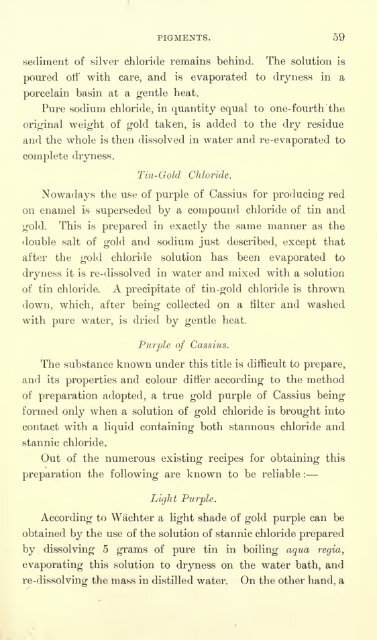Enamels and enamelling; an introduction to the preparation and ...
Enamels and enamelling; an introduction to the preparation and ...
Enamels and enamelling; an introduction to the preparation and ...
Create successful ePaper yourself
Turn your PDF publications into a flip-book with our unique Google optimized e-Paper software.
PIGMENTS. 59<br />
sediment of silver chloride remains behind. The solution is<br />
poured oft' with care, <strong><strong>an</strong>d</strong> is evaporated <strong>to</strong> dryness in a<br />
porcelain basin at a gentle heat.<br />
Pure sodium chloride, in qu<strong>an</strong>tity equal<br />
<strong>to</strong> one- fourth <strong>the</strong><br />
original weight of gold taken, is added <strong>to</strong> <strong>the</strong> dry residue<br />
<strong><strong>an</strong>d</strong> <strong>the</strong> whole is <strong>the</strong>n dissolved in water <strong><strong>an</strong>d</strong> re-evaporated <strong>to</strong><br />
complete dryness.<br />
Tin-Gold Chloride.<br />
Nowadays <strong>the</strong> use of purple of Cassius for producing red<br />
on enamel is superseded by a compound chloride of tin <strong><strong>an</strong>d</strong><br />
gold. This is prepared in exactly <strong>the</strong> same m<strong>an</strong>ner as <strong>the</strong><br />
double salt of gold <strong><strong>an</strong>d</strong> sodium just described, except that<br />
after <strong>the</strong> gold chloride solution has been evaporated <strong>to</strong><br />
dryness<br />
it is re-dissolved in water <strong><strong>an</strong>d</strong> mixed with a solution<br />
of tin chloride. A precipitate of tin-gold chloride is thrown<br />
down, which, after being collected on a filter <strong><strong>an</strong>d</strong> washed<br />
with pure water, is dried by gentle heat.<br />
Purple of Cassius.<br />
The subst<strong>an</strong>ce known under this title is difficult <strong>to</strong> prepare,<br />
<strong><strong>an</strong>d</strong> its properties <strong><strong>an</strong>d</strong> colour differ according <strong>to</strong> <strong>the</strong> method<br />
of <strong>preparation</strong> adopted, a true gold purple of Cassius being<br />
formed only when a solution of gold chloride is brought in<strong>to</strong><br />
contact with a liquid containing both st<strong>an</strong>nous chloride <strong><strong>an</strong>d</strong><br />
st<strong>an</strong>nic chloride.<br />
Out of <strong>the</strong> numerous existing recipes for obtaining this<br />
<strong>preparation</strong> <strong>the</strong> following<br />
are known <strong>to</strong> be reliable :<br />
Light Purple.<br />
According <strong>to</strong> Wachter a light shade of gold purple c<strong>an</strong> be<br />
obtained by <strong>the</strong> use of <strong>the</strong> solution of st<strong>an</strong>nic chloride prepared<br />
by dissolving 5 grams of pure tin in boiling aqua regia,<br />
evaporating this solution <strong>to</strong> dryness on <strong>the</strong> water bath, <strong><strong>an</strong>d</strong><br />
re-dissolving <strong>the</strong> mass in distilled water. On <strong>the</strong> o<strong>the</strong>r h<strong><strong>an</strong>d</strong>, a
















